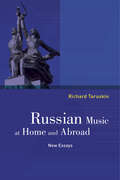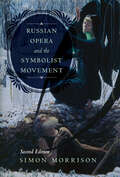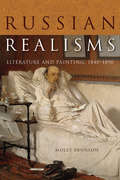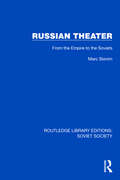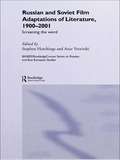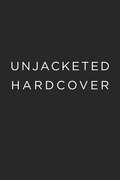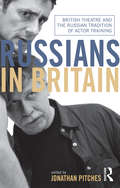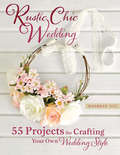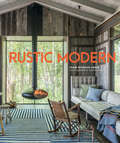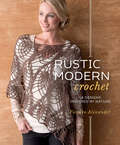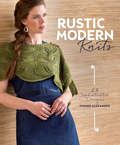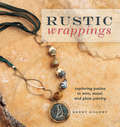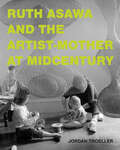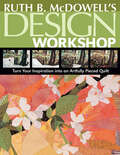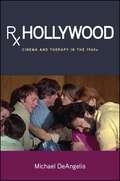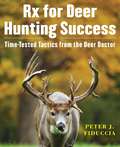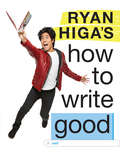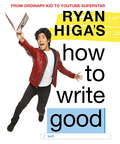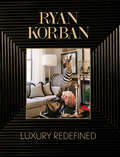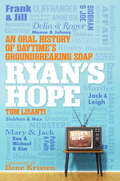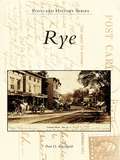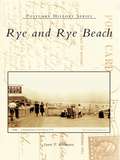- Table View
- List View
Russian Music at Home and Abroad: New Essays
by Richard TaruskinThis new collection views Russian music through the Greek triad of "the Good, the True, and the Beautiful" to investigate how the idea of "nation" embeds itself in the public discourse about music and other arts with results at times invigorating, at times corrupting. In our divided, post–Cold War, and now post–9/11 world, Russian music, formerly a quiet corner on the margins of musicology, has become a site of noisy contention. Richard Taruskin assesses the political and cultural stakes that attach to it in the era of Pussy Riot and renewed international tensions, before turning to individual cases from the nineteenth century to the present. Much of the volume is devoted to the resolutely cosmopolitan but inveterately Russian Igor Stravinsky, one of the major forces in the music of the twentieth century and subject of particular interest to composers and music theorists all over the world. Taruskin here revisits him for the first time since the 1990s, when everything changed for Russia and its cultural products. Other essays are devoted to the cultural and social policies of the Soviet Union and their effect on the music produced there as those policies swung away from Communist internationalism to traditional Russian nationalism; to the musicians of the Russian postrevolutionary diaspora; and to the tension between the compelling artistic quality of works such as Stravinsky’s Sacre du Printemps or Prokofieff’s Zdravitsa and the antihumanistic or totalitarian messages they convey. Russian Music at Home and Abroad addresses these concerns in a personal and critical way, characteristically demonstrating Taruskin’s authority and ability to bring living history out of the shadows.
Russian Opera and the Symbolist Movement, Second Edition (California Studies In 20th-century Music Ser. #2)
by Simon MorrisonAcclaimed for treading new ground in operatic studies of the period, Simon Morrison’s influential and now-classic text explores music and the occult during the Russian Symbolist movement. Including previously unavailable archival materials about Prokofiev and Tchaikovsky, this wholly revised edition is both up to date and revelatory. Topics range from decadence to pantheism, musical devilry to narcotic-infused evocations of heaven, the influence of Wagner, and the significance of contemporaneous Russian literature. Symbolism tested boundaries and reached for extremes so as to imagine art uniting people, facilitating communion with nature, and ultimately transcending reality. Within this framework, Morrison examines four lesser-known works by canonical composers—Pyotr Tchaikovsky, Nikolay Rimsky-Korsakov, Alexander Scriabin, and Sergey Prokofiev—and in this new edition also considers Alexandre Gretchaninoff’s Sister Beatrice and Alexander Kastalsky’s Klara Milich, while also making the case for reviving Vladimir Rebikov’s The Christmas Tree.
Russian Realisms: Literature and Painting, 1840–1890 (NIU Series in Slavic, East European, and Eurasian Studies)
by Molly BrunsonOne fall evening in 1880, Russian painter Ilya Repin welcomed an unexpected visitor to his home: Lev Tolstoy. The renowned realists talked for hours, and Tolstoy turned his critical eye to the sketches in Repin's studio. Tolstoy's criticisms would later prompt Repin to reflect on the question of creative expression and conclude that the path to artistic truth is relative, dependent on the mode and medium of representation. In this original study, Molly Brunson traces many such paths that converged to form the tradition of nineteenth-century Russian realism, a tradition that spanned almost half a century—from the youthful projects of the Natural School and the critical realism of the age of reform to the mature masterpieces of Tolstoy, Fyodor Dostoevsky, and the paintings of the Wanderers, Repin chief among them. By examining the classics of the tradition, Brunson explores the emergence of multiple realisms from the gaps, disruptions, and doubts that accompany the self-conscious project of representing reality. These manifestations of realism are united not by how they look or what they describe, but by their shared awareness of the fraught yet critical task of representation. By tracing the engagement of literature and painting with aesthetic debates on the sister arts, Brunson argues for a conceptualization of realism that transcends artistic media. Russian Realisms integrates the lesser-known tradition of Russian painting with the familiar masterpieces of Russia's great novelists, highlighting both the common ground in their struggles for artistic realism and their cultural autonomy and legitimacy. This erudite study will appeal to scholars interested in Russian literature and art, comparative literature, art history, and nineteenth-century realist movements.
Russian River
by Valerie A. Munthe John C. SchubertThe Russian River region has morphed from a lumber area, to a recreational paradise, to a retirement locale and a semi-bedroom community of Santa Rosa Valley, all the while sustaining itself as one of Northern California's premier vacation destinations. Each resort region town has its own personality dictated by its environment: forest, river, fields, and hills. A self-proclaimed "River Rat," Valerie A. Munthe has lived 20 years in Guerneville, where she and her husband, Jesse, raise their two children. John C. Schubert, who has lived on the Russian River for 55 years, is a former U.S. Marine, a retired deputy, and a local writer and historian of some note.
Russian Theater: From the Empire to the Soviets (Routledge Library Editions: Soviet Society)
by Marc SlonimRussian Theater (1963) is a comprehensive study of the main trends in Russian theatre in the nineteenth and twentieth centuries. Beginning with its origins in pagan folklore and ritual, it goes on to consider the romantic drama which flourished in the first half of the nineteenth century, the realistic drama of Gogol, Turgenev and their contemporaries, and the beginning of the modernist movement. The foundation of the famous Moscow Art Theatre in 1898 by Stanislavsky and Danchenko led to a remarkable period of innovation in acting, production and stage design which still influences the theatre of the West. Their association of Chekhov and their production of his plays is fully described. The reader is also introduced to the work of such playwrights as Andreyev and Gorky, and to the experiments and ideas of directors like Meeyerhold, Tairov and Vakhtangov. A large part of the book is devoted to a systemic analysis of plays and trends under the Soviets and the rise and fall of the avant-garde theatres and the reasons for their replacement by conservative realism.
Russian and Soviet Film Adaptations of Literature, 1900-2001: Screening the Word (BASEES/Routledge Series on Russian and East European Studies #Vol. 18)
by Stephen Hutchings Anat VernitskiProviding many interesting case studies and bringing together many leading authorities on the subject, this book examines the importance of film adaptations of literature in Russian cinema, especially during the Soviet period when the cinema was accorded a vital role in imposing the authority of the communist regime on the consciousness of the Soviet people.
Russian and Soviet Views of Modern Western Art: 1890s to Mid-1930s
by Ilia DorontchenkovIntroducing a wealth of little-known material set in an illuminating interpretive context, this sourcebook presents Russian and Soviet views of Western art during this critical period of cultural transformation. The writings document complex responses to these works and ideas before the Russians lost contact with them almost entirely.
Russians in Britain: British Theatre and the Russian Tradition of Actor Training
by Jonathan PitchesFrom Komisarjevsky in the 1920s, to Cheek by Jowl’s Russian ‘sister company’ almost a century later, Russian actor training has had a unique influence on modern British theatre. Russians in Britain, edited by Jonathan Pitches, is the first work of its type to identify a relationship between both countries’ theatrical traditions as continuous as it is complex. Unravelling new strands of transmission and translation linking the great Russian émigré practitioners to the second and third generation artists who responded to their ideas, Russians in Britain takes in: Komisarjevsky and the British theatre establishment. Stanislavsky in the British conservatoire. Meyerhold in the academy. Michael Chekhov in the private studio. Littlewood’s Theatre Workshop and the Northern Stage Ensemble. Katie Mitchell, Declan Donnellan and Michael Boyd. Charting a hitherto untold story with historical and contemporary implications, these nine essays present a compelling alternative history of theatrical practice in the UK.
Rustic Chic Wedding: 55 Projects for Crafting Your Own Wedding Style
by Morgann HillRustic Chic Wedding is a bride and groom's peek into the vintage-inspired, timeless wedding of their dreams. A little DIY with a whiff of romance and whimsy goes a long way toward wedding-day magic.Choose from any of the three beautiful wedding "themes.” Maybe your wedding style is Shabby Vintage Couture Wedding: try the Garden Table Numbers or Monogrammed Cake Stand. Or if the Rustic, Recycled & Re-purposed Wedding is more your speed, there's a Flower Girl Crown and Kissing Bell. The Urban Farmhouse Wedding has instructions for creating a Twig Cake Topper and a S'mores Bar. However you mix and match the projects, your wedding will express your love story, inside and out!With a chapter on creating the perfect themed tablescape and one dedicated to beautiful bridal bouquets and boutonnieres, Rustic Chic Wedding will be an indispensable guide on the sweetest day of your life..
Rustic Elegance
by Ralph KylloeA collection of breathtaking log cabins where everything new is old again, from the author of Ralph Kylloe&’s Rustic Living. Exuding luxury and comfort, history and innovation, here are thirteen newly handcrafted log and stone homes that surpass all expectations of quality and creativity. All are the creations of Larry Pearson, AIA, who is recognized as a leader in rustic design. These luxurious cabins from Montana, Wyoming, Connecticut, Wisconsin, Minnesota and California are replete with hand-hewn logs, dry-stacked stone, artistic doors and staircases, and furnishings that meld modern convenience with age-old beauty. Pearson Design Group was the recipient of Mountain Living Magazine&’s prestigious 2009 Home of the Year Award and has been featured on HGTV&’S Spectacular Homes.
Rustic Modern
by Chase Reynolds EwaldThis lushly photographed home design book offers an intimate tour through rustic modern residences across California and the Mountain West. Following their acclaimed volume American Rustic, design writer Chase Reynolds Ewald and photographer Audrey Hall have teamed up once again to explore fifteen Western homes with a fresh take on rustic style. Here you&’ll find contemporary approaches to traditional log cabins, sustainable projects, artist studios, and places for play. The inspired interior decor and exteriors are all beautifully photographed and discussed in elegant prose.Rustic Modern also offers detailed perspectives from the homeowners, architects, and designers who brought these diverse spaces to life. Individual home&’s stories are complemented by full-page photography. The rustic textiles, warm living spaces, uniquely crafted chandeliers suspend from vaulted ceilings, and sweeping vistas out every window are sure to inspire.
Rustic Modern Crochet: 18 Designs Inspired by Nature
by Yumiko AlexanderA collection of unique and sophisticated crochet designs!Enjoy Yumiko Alexander's showcase of eighteen clean, sophisticated crochet designs. Her garments feature eye-catching construction based on very simple lines that come together in unexpected ways. Stitch patterns have central focus here, as the silhouettes or shapes are kept simple to emphasize the crocheted fabric. Yumiko's pieces are versatile enough that they can be dressed up or down according to your fancy.Yumiko takes her inspiration from the natural worldâ€"tide-swept sand, shells, coral, shale rock formations, the colors of sunset. Her nature-inspired palette is brought to life using luscious yarns that are as pleasing to the hand as they are to the eye. These designs will appeal to crocheters seeking a more upscale look in their garments. Rustic Modern Crochet features designs in subtle earth tones and warm sunset hues that hold a cross-generational appeal.
Rustic Modern Knits: 23 Sophisticated Designs
by Yumiko AlexanderRustic, organic, urban, natural-a collection of unique knitted accessories. Enjoy a clean, sophisticated take on knitting with Rustic Modern Knits. Yumiko Alexander's collection of 23 knitted accessories takes its inspiration from the natural world. Her knitted headbands, shawls, wraps, mitts, hats, and more all reflect her interest in nature's beauty-verdant leaves, flowers, shells, waves, and colors inspired by sunsets and stone. Versatile knitting designs allow a shawl to become a scarf or a cape by making just a few slight adjustments. Stitch patterns and easy techniques have central focus here, as the silhouettes or shapes are kept simple to emphasize the knitted fabric. Yumiko's knitting designs are fashion-forward but never trendy--they exist in a sphere all their own. Despite or perhaps because of their organic and rustic feel, they are very much at home in a cosmopolitan setting, and should appeal to knitters looking for beautiful and unique knitting projects to wear.
Rustic Wrappings: Exploring Patina in Wire, Metal, and Glass Jewelry
by Kerry BogertExplore a rustic approach to making beautiful jewelry with exciting surface effects. Rustic Wrappings is packed with more than 24 wire and art bead jewelry projects and reveals the surprisingly artistic effects of applying materials such as salt, vinegar, bleach, sawdust, and baking soda to copper, silver, brass, and steel wire projects.Rustic Wrappings explores how to use patinas to add rustic, weathered effects, creating unique and natural-looking color combinations, as well as how to use metal wire to embroider designs on metal jewelry pieces. With tons of information on customizing effects for unique metal finishes, Rustic Wrappings will teach you to reimagine your wirework jewelry projects and create fresh designs that showcase your new skill sets.
Rutgers Then and Now: Two Centuries of Campus Development: A Historic and Photographic Odyssey
by Richard L. Edwards David Listokin James W. HughesRutgers University has come a long way since it was granted a royal charter in 1766. As it migrated from a parsonage in Somerville, to the New Brunswick-sited Sign of the Red Lion tavern, to stately Old Queens, and expanded northward along College Avenue, it would both compete and collaborate with the city that surrounded it for room to grow. Rutgers, Then and Now tells this story, proceeding through ten sequential development phases of College Avenue and Piscataway campus expansions—each with its own buildings and physical layouts—that took place over the course of 250 years. It delivers stunning photographic and historic documentation of the growth of the university, showing “what it was and appeared originally” versus “what it is and looks like today.” Among other in-depth analyses, the book compares the diminutive geographic scale of today’s historical College Avenue Campus—once the entirety of Rutgers—to the much larger-sized (in acreage) Busch Campus. Replete with more than 500 images, the book also considers the Rutgers campuses that might have been, examining plans that were changed or abandoned. Shedding light on the sacrifices and gifts that transformed a small college into a vital hub for research and beloved home for students, it explores how Rutgers grew to become a world-class university.
Ruth Asawa and the Artist-Mother at Midcentury
by Jordan TroellerHow a group of artist-mothers in postwar San Francisco refused the centuries-old belief that a woman could not make art while also raising children.For most of modern history, to be an artist and a mother was to embody a contradiction in terms. This &“awful dichotomy,&” as painter Alice Neel put it, pitted artmaking against caretaking and argued that the best art was made at the expense of family and futurity. But in San Francisco in the 1950s and 1960s, a group of artists gathered around Ruth Asawa (1926–2013) began to reject this dominant narrative. In Ruth Asawa and the Artist-Mother at Midcentury, Jordan Troeller analyzes this remarkable moment. Insisting that their labor as mothers fueled their labor as artists, these women redefined key aesthetic concerns of their era, including autonomy, medium specificity, and originality.Delving into the archive, where the traces of motherhood have not yet been erased from official history, Troeller reveals Ruth Asawa&’s personal and professional dialogue with several other artist-mothers, including Merry Renk, Imogen Cunningham, and Sally Woodbridge. For these women, motherhood was not an essentialized identity, but rather a means to reimagine the terms of artmaking outside of the patriarchal policing of reproduction. This project unfolded in three broad areas, which also structure the book&’s chapters: domesticity and decoration; metaphors for creativity; and maternal labor in the public sphere, especially in the public schools. Drawing on queer theory and feminist writings, Troeller argues that in belatedly accounting for the figure of the artist-mother, art history must reckon with an emergent paradigm of artmaking, one predicated on reciprocity, caretaking, and futurity.
Ruth B. McDowell's Design Workshop: Turn Your Inspiration into an Artfully Pieced Quilt
by Ruth B. McDowellThe master piecer teaches you to design unforgettable art quilts from your own images. Companion to her piecing book.
Rx Hollywood: Cinema and Therapy in the 1960s (SUNY series, Horizons of Cinema)
by Michael DeAngelisRx Hollywood investigates how therapy surfaced in the themes, representations, and narrative strategies of a changing film industry. In the 1960s and early 1970s, American cinema was struggling to address adult audiences who were increasingly demanding films that confronted contemporary issues. Focusing upon five fields of therapeutic inquiry—therapist/patient dynamics, female "frigidity" and male impotence, marital discord, hallucinogenic drug use, and the dynamics of confession—Michael DeAngelis argues that the films of this period reveal an emergent, common tendency of therapy to work toward the formation of a stronger sense of interpersonal, community/social, and political engagement, counteracting alienation and social division in the spirit of connection and community.Prior to the 1960s, therapy had been considered an introspective process, one that emphasized contemplation and insight and prompted the patient to investigate memories and past traumas. In the 1960s, however, therapy would move toward more humanistic, client-centered, community, group, and encounter models that deemphasized the "there and then" of past feelings and experiences and embraced the "here and now" of the present. These kinds of therapy promised to heal the self through a process of reaching out, helping individuals to connect with communities, support networks, and other like-minded individuals who shared a needed sense of belonging.Drawing on a wide range of films, including Marnie, The Boston Strangler, The Chapman Report, Carnal Knowledge, Divorce American Style, Diary of a Mad Housewife, Guess Who's Coming to Dinner, and Five Easy Pieces, DeAngelis shows how American culture framed therapeutic issues as problems of human communication, developing treatment strategies that addressed individual psychological problems as social problems.
Rx for Deer Hunting Success: Time-Tested Tactics from the Deer Doctor
by Peter J. FiducciaThis ground-breaking book is loaded with new scientific research that will help you become a better deer hunter.This comprehensive guide provides a compilation of in-depth coverage on all methods used to hunt whitetail deer consistently and successfully. Fiduccia’s real-world hunting strategies will benefit both the novice and the veteran deer hunter. Each chapter is specifically designed to provide readers with enhanced skills through innovative tips, as well as strategies to help take their deer hunting success to the next level.Many of the chapters include information rarely seen in print before. Fiduccia shares his five decades of whitetail hunting wisdom and experience in a manner that is easy to understand and apply. His tactics combine time-tested hunting strategies with the most up-to-date scientific research on white-tailed deer. Anyone who reads The Deer Doctor’s Rx to Whitetail Hunting Success will gain the edge in becoming a more effective deer hunter.Skyhorse Publishing is proud to publish a broad range of books for hunters and firearms enthusiasts. We publish books about shotguns, rifles, handguns, target shooting, gun collecting, self-defense, archery, ammunition, knives, gunsmithing, gun repair, and wilderness survival. We publish books on deer hunting, big game hunting, small game hunting, wing shooting, turkey hunting, deer stands, duck blinds, bowhunting, wing shooting, hunting dogs, and more. While not every title we publish becomes a New York Times bestseller or a national bestseller, we are committed to publishing books on subjects that are sometimes overlooked by other publishers and to authors whose work might not otherwise find a home.
Ryan Higa's How to Write Good
by Ryan Higa<P>An unconventional, irreverent, yet heartfelt memoir by Ryan Higa, one of the top creators on YouTube. With pictures! And illustrations! And, y'know, words. <P>I know you're used to seeing me on the Internet, but here I am, coming at you in book form. You might be asking yourself, A Book? You? Why? Great question! Why did I write a book? Listen, I'm as surprised about it as you are. But I have a story to tell that I believe will help inspire people who are going through tough times to not only persevere through those tough times but to excel in them. And I couldn't be the only YouTuber without a book, could I? <P>So, welcome to Ryan Higa's How to Write Good, by me, Ryan Higa. This is the story of how I went from being a relatively happy kid to being depressed and angry and filled with dark thoughts. This is the story of how I thought I had only one way out of this cruel world. This is the story of how I found a better way. But wait, there's more! <P>You're not only getting my story but you'll also learn how to write good--I mean well--from a college dropout who struggled in basic-level English classes and still became a legit, published Best Sailing Author. (That wasn't a typo. I plan to buy a boat one day...but probably not anytime soon. This book might not cell good.) <P><b>A New York Times Bestseller</b>
Ryan Higa's How to Write Good
by Ryan HigaAn unconventional, irreverent, yet heartfelt memoir by Ryan Higa, one of the top creators on YouTube. With pictures! And illustrations! And, y'know, words. Now a New York Times bestseller!I know you're used to seeing me on the Internet, but here I am, coming at you in book form. You might be asking yourself, A book? You? Why? Listen, I'm as surprised about it as you are. But I have a story to tell that I believe will help inspire people who are going through tough times. And I couldn't be the only YouTuber without a book, could I?This is the story of how I went from being a relatively happy kids to being depressed and angry and filled with dark thoughts. This is also the story of how I found my way to a happier life. But wait, there's more! You're not only getting my story but you'll also learn to write well, from a college dropout who struggled in basic-level English classes and still became a legit, Best Sailing Author. (That wasn't a typo. I plan to buy a boat one day...but probably not anytime soon. This book might not cell good.)
Ryan Korban
by Ryan KorbanRyan Korban has redefined luxury for a new generation, with an approach to interior design that infuses a timeless sensibility with a sense of lost romance, sex, fantasy, and a strong fashion influence. In this beautiful book filled with more than one hundred full-color photographs, the acclaimed interior designer, who is making a career of translating this aesthetic into elegant, comfortable interiors, shows readers how to achieve a sense of luxury in their homes that is at once glamorous and highly personal.Each of the book's seven thematic chapters focuses on a key component or influence that is essential to Korban's approach to decorating, and offers numerous sources of inspiration and innovative ideas. Every section also includes an introductory essay that explains his point of view on the subject, followed by a seamless flow of captioned images that expresses it in detail and from various visual perspectives. The photographs of spaces he has designed--including homes for celebrity clients--are complemented by images from fashion, advertising, fine art, and design that will inspire readers with their compelling juxtaposition and enhance the luxurious aesthetic. A Sources section listing Korban's go-to shops for everything from flowers to furniture rounds out this stunning book that is as alluring as the spaces featured within.With more than 100 full-color photographs throughout
Ryan's Hope: An Oral History of Daytime's Groundbreaking Soap
by Tom LisantiIn the vein of the bestselling Nothing General About It and Always Young and Restless, a revelatory account of the pioneering Emmy Award-winning, beloved daytime drama— featuring the words of stars including Helen Gallagher, Malcolm Groome, Ron Hale, Ilene Kristen, Michael Levin, Ana Alicia, Roscoe Born, Catherine Hicks, Geoff Pierson, Andrew Robinson, and Gordon Thompson, along with writers, producers, directors and family members—plus never-before-seen photos and plot synopses. From the opening scene of its first episode, in which Mary Ryan walks jauntily down a New York City street to her family&’s neighborhood bar, it was clear that Ryan&’s Hope would be unlike every daytime soap that had come before. Indeed, from 1975 to 1989, the Emmy award-winning ABC TV serial drew viewers into the world of Maeve and Johnny Ryan, their children, friends, and extended family. This page-turning chronicle gathers memories and exclusive interviews to reveal the show&’s fascinating origin story—and explore why it&’s missed to this day. Ryan&’s Hope was set in a real city, within recognizable communities. The working-class, Irish-Catholic, immigrant Ryans were the core of a show that credibly tackled such topics as infidelity, addiction, religious faith, and women&’s rights. There was melodrama, to be sure, but also heart, depth, grit—provided by co-creators and head writers Claire Labine and Paul Avila Mayer. Labine and Mayer were also the executive producers in the early years, which gave them full control over their creation, from character backstories to lighting and costume. But there were also some missteps along the way, from the constant recasting of fan-favorite characters to ABC&’s ill-judged attempts to infuse the homey, family-oriented show with intrigue and adventure. Featuring the words of stars including Helen Gallagher, Malcolm Groome, Ron Hale, Ilene Kristen, Michael Levin, Ana Alicia, Roscoe Born, Catherine Hicks, Geoff Pierson, Andrew Robinson, and Gordon Thomson, along with writers, producers, production crew, and family members—plus never-before-seen photos and plot synopses—soap opera fans will find this insider account as captivating as the beloved show itself.
Rye
by Paul D. RheingoldRye, now a suburb of New York City, has a fascinating history dating from its founding in 1660. Due to its extensive waterfront on Long Island Sound, Rye has been home to several major amusement parks, as well as beaches and nearly a dozen clubs. These clubs have featured sailing, golf, and swimming, and numerous postcard scenes in Rye show the ways in which residents entertained themselves over the years. Rye also contains plentiful views of the churches and schools in town, which date back well into the 19th century. The town has had a number of famous private schools and institutions, including St. Benedict's Home for Colored Children and the Osborn. Scenes also show civic buildings, such as the fire stations, post offices, train stations, and the mansions of the wealthy.
Rye and Rye Beach (Postcard History)
by Lewis T. KarabatsosAlthough small, the town of Rye played a significant role in New Hampshire's history and in nineteenth-century lifestyle and recreation. From its beginnings in 1623, Rye was predominantly a farming and fishing community. In the years prior to the Civil War, however, local entrepreneurs recognized the potential of their seacoast location and began catering to the needs of wealthy Victorians seeking a temporary escape from urban living. These entrepreneurs exploited the restorative powers of the ocean and established boardinghouses and grand hotels that gained national recognition. By the 1890s, the Rye Beach area had peaked as a summer resort destination and began to evolve into a summer residence colony. Houses of grand scale and variety began to appear. Later, with the introduction of the automobile and the extension of cable-car systems up the coast, Rye and Rye Beach became more accessible for day trips to the ocean.
